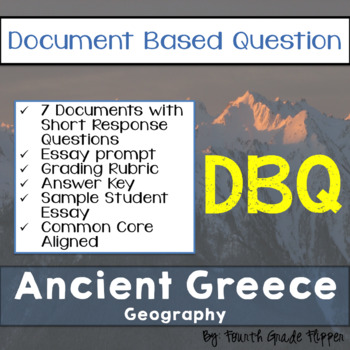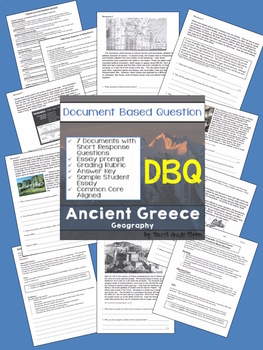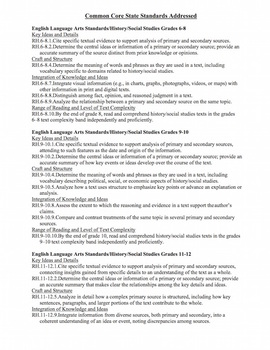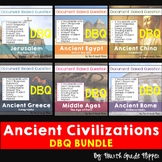DBQ Ancient Greece Document Based Question
Fourth Grade Flipper
3.6k Followers
Grade Levels
5th - 12th, Homeschool
Subjects
Resource Type
Standards
CCSSRH.6-8.1
CCSSRH.6-8.2
CCSSRH.6-8.4
CCSSRH.6-8.7
CCSSRH.6-8.8
Formats Included
- Zip
Pages
31 pages
Fourth Grade Flipper
3.6k Followers
What educators are saying
We really enjoyed using this! Straightforward with easy to follow explanations. This will help my students prepare for the future DBQ questions they are sure to encounter in high school.
Also included in
- *BEST SELLER BUNDLE*This is a set of six Ancient History DBQs that are also offered separately for $4.00 each. Buy the set and save versus purchasing them individually. These DBQs address the Common Core State Standards. They have a page outlining the English Language Arts/History/Social StudiesPrice $16.00Original Price $24.00Save $8.00
Description
This DBQ addresses the Common Core State Standards. It has been updated with a page outlining the English Language Arts/History/Social Studies grades 6-8, 9-10, and 11-12 CCSS that it addresses.
**You can buy all SIX Ancient History DBQ's in a separate listing here and SAVE over $10.00 vs. buying them individually!**
This Document Based Question (DBQ) was created for 6th Grade World History. It could also be used in 9th grade Global Studies. The topic is Ancient Greece Geography. It follows the format of the New York State social studies testing requirements for writing DBQ's and answering CRQ's. The DBQ packet has seven pages of primary or secondary source documents with constructed response questions followed by an essay question using the documents. The constructed response questions give plenty of space for the students to write instead of the tiny lines that you sometimes find on worksheets. Part One has a total possible 25 points and a scoring rubric is included for the essay (1-5).
*UPDATE* The DBQ also includes my handwritten answer key for part one scanned as a PDF as well as example scanned student essays (16 pages).
I originally took the time to create all these DBQ's for a graduate class project. I knew they would be useful since I couldn't find anything for sixth grade ancient history DBQ's at that time. It took a lot of time to create them and I don't know if I would have done it had it not been for a graduate class. They have been well worth the time and I have given them to many colleagues. I hope you find them useful as well!
From the Library of Congress: Teaching with Primary Sources Website:
"Under the English Language Arts standards, students beginning in the earliest grades must substantiate written arguments with evidence. The Common Core approaches science and social studies with a particular emphasis on literacy. This has several implications for teaching with primary sources. The CCSS greatly increase the focus on informational text at all grades. Assessment designers explicitly recommend a 50-50 split between literature and informational texts, starting at the primary grades. Students’ capacity to source, organize, analyze, cite, discuss, and write about information gained from both primary and secondary sources is paramount."
Note: This is a PDF file and is NOT editable due to copyright.
**You can buy all SIX Ancient History DBQ's in a separate listing here and SAVE over $10.00 vs. buying them individually!**
This Document Based Question (DBQ) was created for 6th Grade World History. It could also be used in 9th grade Global Studies. The topic is Ancient Greece Geography. It follows the format of the New York State social studies testing requirements for writing DBQ's and answering CRQ's. The DBQ packet has seven pages of primary or secondary source documents with constructed response questions followed by an essay question using the documents. The constructed response questions give plenty of space for the students to write instead of the tiny lines that you sometimes find on worksheets. Part One has a total possible 25 points and a scoring rubric is included for the essay (1-5).
*UPDATE* The DBQ also includes my handwritten answer key for part one scanned as a PDF as well as example scanned student essays (16 pages).
I originally took the time to create all these DBQ's for a graduate class project. I knew they would be useful since I couldn't find anything for sixth grade ancient history DBQ's at that time. It took a lot of time to create them and I don't know if I would have done it had it not been for a graduate class. They have been well worth the time and I have given them to many colleagues. I hope you find them useful as well!
From the Library of Congress: Teaching with Primary Sources Website:
"Under the English Language Arts standards, students beginning in the earliest grades must substantiate written arguments with evidence. The Common Core approaches science and social studies with a particular emphasis on literacy. This has several implications for teaching with primary sources. The CCSS greatly increase the focus on informational text at all grades. Assessment designers explicitly recommend a 50-50 split between literature and informational texts, starting at the primary grades. Students’ capacity to source, organize, analyze, cite, discuss, and write about information gained from both primary and secondary sources is paramount."
Note: This is a PDF file and is NOT editable due to copyright.
Total Pages
31 pages
Answer Key
Included with rubric
Teaching Duration
90 minutes
Report this resource to TPT
Reported resources will be reviewed by our team. Report this resource to let us know if this resource violates TPT’s content guidelines.
Standards
to see state-specific standards (only available in the US).
CCSSRH.6-8.1
Cite specific textual evidence to support analysis of primary and secondary sources.
CCSSRH.6-8.2
Determine the central ideas or information of a primary or secondary source; provide an accurate summary of the source distinct from prior knowledge or opinions.
CCSSRH.6-8.4
Determine the meaning of words and phrases as they are used in a text, including vocabulary specific to domains related to history/social studies.
CCSSRH.6-8.7
Integrate visual information (e.g., in charts, graphs, photographs, videos, or maps) with other information in print and digital texts.
CCSSRH.6-8.8
Distinguish among fact, opinion, and reasoned judgment in a text.






